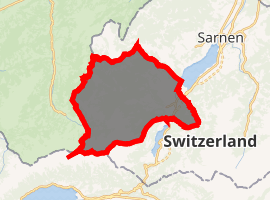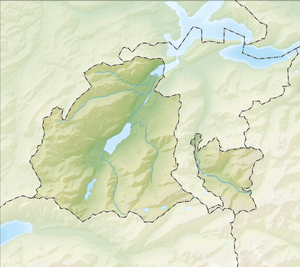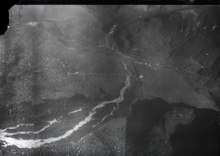Giswil
Giswil is a municipality in the canton of Obwalden in Switzerland.
Giswil | |
|---|---|
Giswil and Sarnersee as seen from Brünigstrasse in August 2016 | |
 Coat of arms | |
Location of Giswil 
| |
 Giswil  Giswil | |
| Coordinates: 46°50′N 8°11′E | |
| Country | Switzerland |
| Canton | Obwalden |
| District | n.a. |
| Area | |
| • Total | 85.96 km2 (33.19 sq mi) |
| Elevation | 485 m (1,591 ft) |
| Population (2018-12-31)[2] | |
| • Total | 3,657 |
| • Density | 43/km2 (110/sq mi) |
| Postal code | 6074 |
| SFOS number | 1403 |
| Surrounded by | Flühli (LU), Hofstetten bei Brienz (BE), Lungern, Sachseln, Sarnen, Schwanden bei Brienz (BE) |
| Website | www SFSO statistics |
History
Giswil is first mentioned in the 11th Century as Kisevilare.[3]
Geography

The municipality is located on the southern end of Lake Sarnen. It consists of the village sections of Grossteil, Kleinteil, Rudenz and Diechtersmatt, as well as scattered farm houses and hamlets. To the south-west, the municipality rises up to the summits of the Giswilerstock, Brienzer Rothorn, Arnihaaggen and Höch Gumme. The Glaubenbielen Pass crosses to Sörenberg in the Entlebuch region of the canton of Lucerne.[4]

Giswil has an area, as of 2006, of 85.9 square kilometers (33.2 sq mi). Of this area, 35.9% is used for agricultural purposes, while 53.3% is forested. Of the rest of the land, 2.2% is settled (buildings or roads) and the remainder (8.7%) is non-productive (rivers, glaciers or mountains).[5]
Demographics
Giswil has a population (as of 31 December 2018) of 3,658.[6] As of 2007, 8.9% of the population was made up of foreign nationals.[7] After a period of poverty and emigration in the late 19th century, where the population stagnated at about 1600 persons, the population increased quite continuously in the 20th century. Over the past 40 years the population has increased by 38%, mainly because economic conditions in the region and public transport to Luzern have improved so that the migration balance definitely changed its sense towards immigration. Most of the population (as of 2000) speaks German (95.5%), with Serbo-Croatian being second most common ( 1.0%) and Portuguese being third ( 0.8%).[5] As of 2000 the gender distribution of the population was 50.9% male and 49.1% female. As of 2000 there are 1,250 households in Giswil.[7]
In the 2007 federal election the most popular party was the SVP which received 35.9% of the vote. The next three most popular parties were the CVP (26.2%), the SPS (19.4%) and the rest of the votes went to other parties (18.6%).[5]
In Giswil about 68.2% of the population (between age 25–64) have completed either non-mandatory upper secondary education or additional higher education (either university or a Fachhochschule).[5]
Giswil has an unemployment rate of 1.24%. As of 2005, there were 329 people employed in the primary economic sector and about 125 businesses involved in this sector. 335 people are employed in the secondary sector and there are 53 businesses in this sector. 467 people are employed in the tertiary sector, with 84 businesses in this sector.[5]
The historical population is given in the following table:[3]
| year | population |
|---|---|
| 1744 | 1,040 |
| 1850 | 1,610 |
| 1900 | 1,711 |
| 1950 | 2,642 |
| 1990 | 3,085 |
| 2000 | 3,435 |
Transport
Giswil is served by Giswil station on the Brünig line, an inter-regional narrow-gauge railway from Interlaken to Lucerne. The hourly InterRegio train between Interlaken and Lucerne stops at the station, which is also the terminus of the half-hourly Lucerne S-Bahn S5 service from Lucerne.
The A8 motorway passes to the south of the town, through the Giswil Tunnel.
Sights
The main sights of Giswil are: two ruins (Rosenberg and Rudenz) and the traditional farmhouses in the scattered settlement Grossteil.
Weather
Giswil has an average of 144.1 days of rain per year and on average receives 1,311 mm (51.6 in) of precipitation. The wettest month is August during which time Giswil receives an average of 168 mm (6.6 in) of precipitation. During this month there is precipitation for an average of 14.4 days. The month with the most days of precipitation is June, with an average of 14.4, but with only 146 mm (5.7 in) of precipitation. The driest month of the year is January with an average of 79 mm (3.1 in) of precipitation over 14.4 days.[8]
References
- "Arealstatistik Standard - Gemeinden nach 4 Hauptbereichen". Federal Statistical Office. Retrieved 13 January 2019.
- "Ständige Wohnbevölkerung nach Staatsangehörigkeitskategorie Geschlecht und Gemeinde; Provisorische Jahresergebnisse; 2018". Federal Statistical Office. 9 April 2019. Retrieved 11 April 2019.
- Giswil in German, French and Italian in the online Historical Dictionary of Switzerland.
- map.geo.admin.ch (Map). Swiss Confederation. Retrieved 2014-10-27.
- Swiss Federal Statistical Office Archived January 5, 2016, at the Wayback Machine accessed 03-Sep-2009
- Swiss Federal Statistical Office - STAT-TAB, online database – Ständige und nichtständige Wohnbevölkerung nach institutionellen Gliederungen, Geburtsort und Staatsangehörigkeit (in German) accessed 23 September 2019
- Canton Obwalden Statistics Archived July 7, 2011, at the Wayback Machine accessed 2 September 2009 (in German)
- "Temperature and Precipitation Average Values-Table, 1961–1990" (in German, French, and Italian). Federal Office of Meteorology and Climatology – MeteoSwiss. Archived from the original on 27 June 2009. Retrieved 8 May 2009., the weather station elevation is 489 meters above sea level.
| Wikimedia Commons has media related to Giswil. |
External links
- Giswil in German, French and Italian in the online Historical Dictionary of Switzerland.